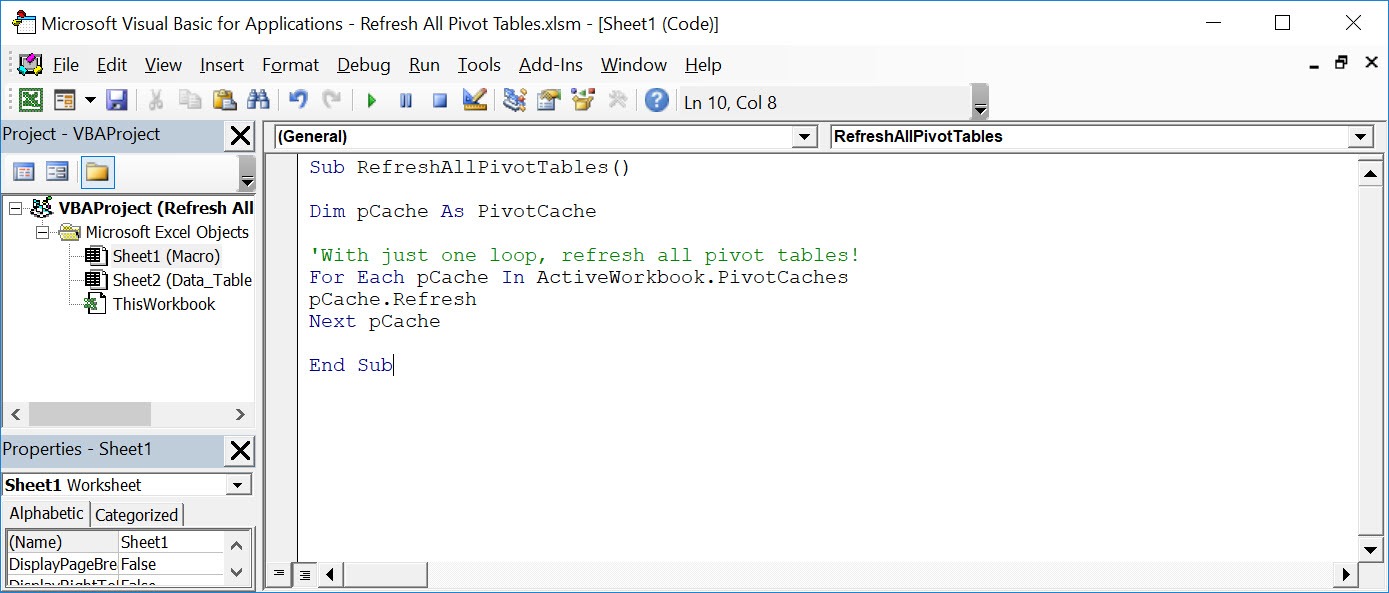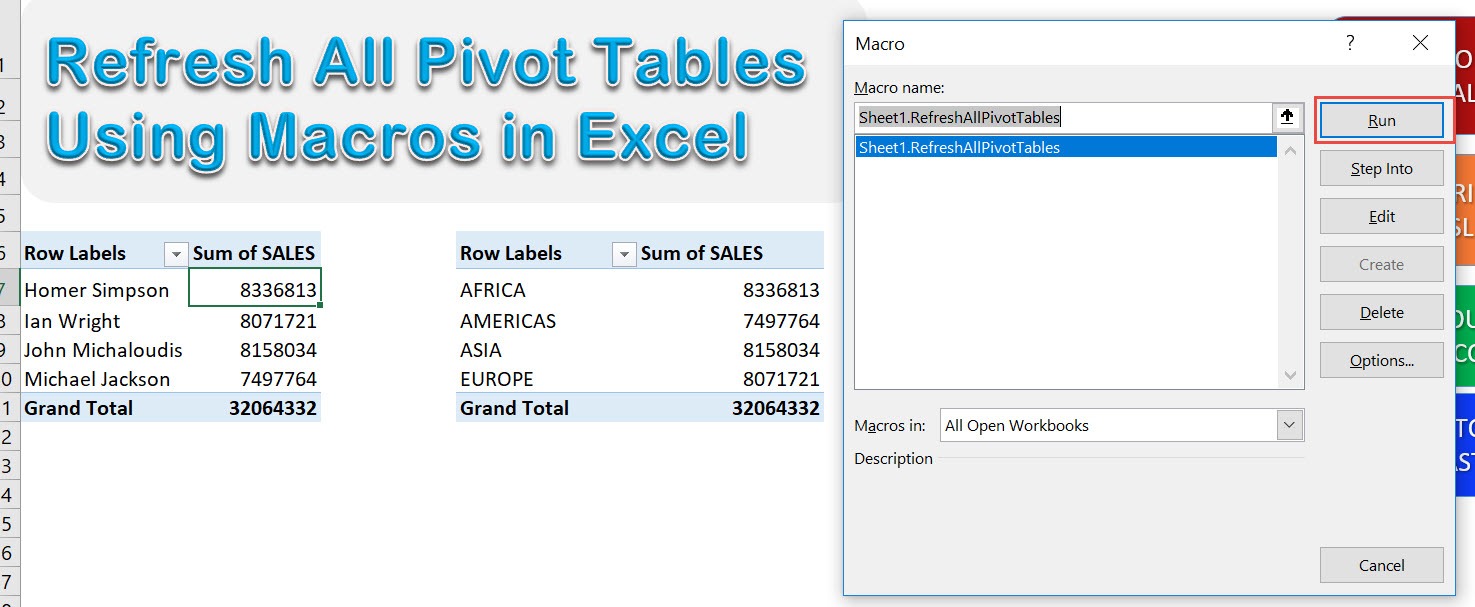As someone who works extensively with large datasets in Excel, I’ve come to appreciate the power and flexibility of pivot tables. They enable me to analyze and summarize information quickly, but I used to find myself frustrated when I needed to update multiple pivot tables after data changes. Refreshing each one manually was time-consuming and inefficient. That’s when I turned to Excel macros—a solution that, once mastered, saves me countless hours and ensures my reports are always up to date. In this article, I’ll walk you through how I refresh all pivot tables using macros, sharing practical tips, real-life insights, and answers to common questions.
Key Takeaways:
- Refreshing all pivot tables using macros saves significant time and ensures data consistency.
- Excel’s VBA Editor is a user-friendly environment for writing, editing, and managing macros.
- Assigning macros to buttons or automating their execution can streamline repetitive analysis tasks.
- Testing, documenting, and securing your macros are essential for safe and effective automation.
- Proactive troubleshooting and regular updates maximize the reliability and longevity of your macros.
Table of Contents
Understanding Macros in Excel
What Are Macros?
From my experience, macros in Excel are like little robots that automate repetitive tasks. I record or write instructions, and then Excel follows them step by step. Macros are written in VBA (Visual Basic for Applications), a programming language built into Microsoft Office, which makes them accessible for most users, including those with minimal coding knowledge. With just a few clicks, I can transform a tedious manual process into an automated workflow. Whether it’s formatting cells, importing data, or generating reports, macros help streamline the entire process. Once set up, they perform flawlessly at the push of a button—eliminating human error and boosting productivity.
Why Use Macros for Pivot Tables?
After working with numerous pivot tables, I realized that refreshing them all at once using macros not only saves time but also reduces the likelihood of missing a table. Macros can refresh all pivot tables in a workbook with a single command, enhancing accuracy and consistency across my reports. They’re especially useful when dealing with dashboards or monthly reports that rely on up-to-date pivot summaries. Instead of manually refreshing each table one by one, a macro handles everything instantly, ensuring that all data points reflect the most recent updates. In more advanced cases, I’ve used macros to not just refresh, but also to dynamically change filters, apply formatting, and even export the final pivot tables to PDF—all in a single automated process.
How to Refresh all Pivot Tables using Macros
STEP 1: Go to Developer > Code > Visual Basic
STEP 2: Paste in your code and Select Save. Close the window afterwards.
Sub RefreshAllPivotTables() Dim pCache As PivotCache 'With just one loop, refresh all pivot tables! For Each pCache In ActiveWorkbook.PivotCaches pCache.Refresh Next pCache End Sub
STEP 3: Let us test it out!
Open the sheet containing the data. Go to Developer > Code > Macros
Make sure your macro is selected. Click Run.
With just one click, all of your pivot tables are now refreshed!
Tips & Tricks
- Backup Your Workbook: Before running any macro, I always save a backup copy. This precaution has saved me more than once from accidental data loss or unexpected results.
- Use Descriptive Macro Names: Naming my macros clearly (e.g., “RefreshAllPivots”) helps me identify and manage them, especially if I create multiple macros for different tasks.
- Test Macros on Sample Data: I prefer testing my macros on a duplicate set of data to ensure they work as expected before applying them to crucial reports.
- Document Macro Functions: Adding comments in VBA (using the apostrophe ‘) helps me and others understand what each part of the code does, making future edits easier.
- Protect Macro Security: Since macros can contain code from external sources, I make sure to enable macros only from trusted files and regularly scan for potential risks.
FAQs
Do I need to know VBA to refresh all pivot tables using macros?
Not necessarily. I started using macros by simply recording actions without writing a single line of code. For basic tasks like refreshing pivot tables, you can copy and paste pre-written code (like the one I shared) into the VBA editor and it works like magic. However, learning a bit of VBA can help you customize macros and troubleshoot issues more effectively. Over time, even a beginner-level understanding goes a long way.
Will this macro refresh all pivot tables across hidden sheets too?
Yes, it will. When I use the macro, it loops through all the pivot caches in the active workbook, regardless of whether the sheets are visible or hidden. That’s a major advantage because I don’t have to worry about missing any data updates tucked away in background tabs. It’s especially helpful in dashboards where some sheets are intentionally hidden from end users.
Can I automate the macro to run when the workbook opens?
Absolutely—and I’ve done this in several projects. You can place the macro inside the Workbook_Open() event within the ThisWorkbook object in the VBA editor. This way, every time someone opens the file, the pivot tables refresh automatically. It’s a great trick for client reports or internal tools where you want fresh data every time without any manual input.
What happens if a pivot table has a broken data connection?
If a pivot table is connected to a missing or broken data source, the macro will try to refresh it but fail—usually triggering an error or warning. In my experience, it’s best to include basic error-handling in the macro to skip over problem tables and keep the rest running. I’ve also added message boxes to notify me if anything goes wrong during the refresh. That way, I catch issues early without disrupting the workflow.
Is there a way to refresh only specific pivot tables using macros?
Yes, and I do this when I’m working with complex workbooks. Instead of looping through all pivot caches, I write a macro that targets pivot tables on a specific worksheet or even by name. This gives me more control—especially when certain pivot tables are dependent on conditional logic or user inputs. It’s all about choosing the right tool for the right scenario, and macros offer that flexibility.

Bryan
Bryan Hong is an IT Software Developer for more than 10 years and has the following certifications: Microsoft Certified Professional Developer (MCPD): Web Developer, Microsoft Certified Technology Specialist (MCTS): Windows Applications, Microsoft Certified Systems Engineer (MCSE) and Microsoft Certified Systems Administrator (MCSA).
He is also an Amazon #1 bestselling author of 4 Microsoft Excel books and a teacher of Microsoft Excel & Office at the MyExecelOnline Academy Online Course.












